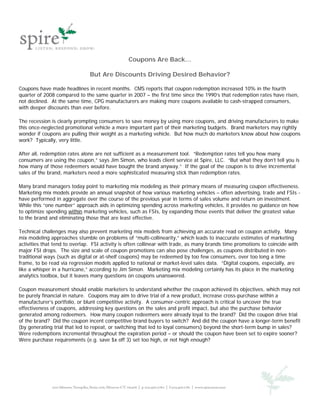
In Spirations-Coupon Effectiveness
- 1. Coupons Are Back… But Are Discounts Driving Desired Behavior? Coupons have made headlines in recent months. CMS reports that coupon redemption increased 10% in the fourth quarter of 2008 compared to the same quarter in 2007 – the first time since the 1990’s that redemption rates have risen, not declined. At the same time, CPG manufacturers are making more coupons available to cash-strapped consumers, with deeper discounts than ever before. The recession is clearly prompting consumers to save money by using more coupons, and driving manufacturers to make this once-neglected promotional vehicle a more important part of their marketing budgets. Brand marketers may rightly wonder if coupons are pulling their weight as a marketing vehicle. But how much do marketers know about how coupons work? Typically, very little. After all, redemption rates alone are not sufficient as a measurement tool. “Redemption rates tell you how many consumers are using the coupon,” says Jim Simon, who leads client service at Spire, LLC. “But what they don’t tell you is how many of those redeemers would have bought the brand anyway.” If the goal of the coupon is to drive incremental sales of the brand, marketers need a more sophisticated measuring stick than redemption rates. Many brand managers today point to marketing mix modeling as their primary means of measuring coupon effectiveness. Marketing mix models provide an annual snapshot of how various marketing vehicles – often advertising, trade and FSIs - have performed in aggregate over the course of the previous year in terms of sales volume and return on investment. While this “one number” approach aids in optimizing spending across marketing vehicles, it provides no guidance on how to optimize spending within marketing vehicles, such as FSIs, by expanding those events that deliver the greatest value to the brand and eliminating those that are least effective. Technical challenges may also prevent marketing mix models from achieving an accurate read on coupon activity. Many mix modeling approaches stumble on problems of “multi-collinearity,” which leads to inaccurate estimates of marketing activities that tend to overlap. FSI activity is often collinear with trade, as many brands time promotions to coincide with major FSI drops. The size and scale of coupon promotions can also pose challenges, as coupons distributed in non- traditional ways (such as digital or at-shelf coupons) may be redeemed by too few consumers, over too long a time frame, to be read via regression models applied to national or market-level sales data. “Digital coupons, especially, are like a whisper in a hurricane,” according to Jim Simon. Marketing mix modeling certainly has its place in the marketing analytics toolbox, but it leaves many questions on coupons unanswered. Coupon measurement should enable marketers to understand whether the coupon achieved its objectives, which may not be purely financial in nature. Coupons may aim to drive trial of a new product, increase cross-purchase within a manufacturer’s portfolio, or blunt competitive activity. A consumer-centric approach is critical to uncover the true effectiveness of coupons, addressing key questions on the sales and profit impact, but also the purchase behavior generated among redeemers. How many coupon redeemers were already loyal to the brand? Did the coupon drive trial of the brand? Did the coupon incent competitive brand buyers to switch? And did the coupon have a longer-term benefit (by generating trial that led to repeat, or switching that led to loyal consumers) beyond the short-term bump in sales? Were redemptions incremental throughout the expiration period – or should the coupon have been set to expire sooner? Were purchase requirements (e.g. save $x off 3) set too high, or not high enough?
- 2. To address these insight needs, Spire has developed a unique approach to measuring coupon effectiveness using its proprietary Loyalty Panel, a transaction-level purchase database currently comprising 15 million households sourced from eight retailers. In addition to measuring incremental volume and ROI, Spire analyzes how coupons change the purchase behavior of redeemers. Based on key consumer metrics among redeemers vs. a matched control set of households, Spire assigns each coupon a “Consumer Role” that summarizes the primary behavior impact of the coupon, such as “Trial Driver” or “Baseline Subsidizer.” For manufacturers seeking to analyze multiple coupons on an ongoing basis, often across several brands in their portfolio, Spire also provides access to a web-based portal for reporting analytic findings. The portal provides an easy, intuitive way for clients to generate best practices internally. Spire’s clients are leveraging coupon effectiveness analysis to guide decisions about which brands to promote with coupons, how high to set face values, how long to set fuse lengths, and how to structure purchase requirements. For instance, one client found that coupons with a consumer role of “Trial Driver” typically had a face value of greater than $1, leading to an internal best-practice recommendation for coupons supporting product introductions. Another client learned that the bar had been set too low on a key annual portfolio event: while the coupon was structured as an “off 3” offer, over a third of redeemers were actually buying 4 or more participating items, leading to revised purchase requirements for the following year’s event. Insights like these lead to better planning, and better alignment between the objective of the coupon and the tactics used to achieve it. Coupon effectiveness analysis can be a cost-effective way to make the recent trends in coupon usage work harder for your brands. For more information, please contact us at Spire. Spire, LLC is a consumer centric analytic services provider. Working with both CPG manufacturers and retailers, Spire leverages their proprietary Loyalty Panel to provide insights on consumer trends, shopping behavior, new product performance, and the consumer impact of pricing and promotion.